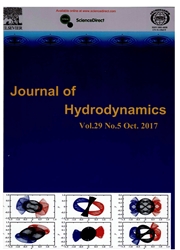

 中文摘要:
中文摘要:
In this paper, we apply a scaling analysis of the maximum of the probability density function(pdf) of velocity increments, i.e., max() = max()up p u, for a velocity field of turbulent Rayleigh-Bénard convection obtained at the Taylor-microscale Reynolds number Re60. The scaling exponent is comparable with that of the first-order velocity structure function, (1), in which the large-scale effect might be constrained, showing the background fluctuations of the velocity field. It is found that the integral time T(x/ D) scales as T(x/ D)(x/ D), with a scaling exponent =0.25 0.01, suggesting the large-scale inhomogeneity of the flow. Moreover, the pdf scaling exponent (x, z) is strongly inhomogeneous in the x(horizontal) direction. The vertical-direction-averaged pdf scaling exponent (x) obeys a logarithm law with respect to x, the distance from the cell sidewall, with a scaling exponent 0.22 within the velocity boundary layer and 0.28 near the cell sidewall. In the cell’s central region, (x, z) fluctuates around 0.37, which agrees well with (1) obtained in high-Reynolds-number turbulent flows, implying the same intermittent correction. Moreover, the length of the inertial range represented in decade()IT x is found to be linearly increasing with the wall distance x with an exponent 0.65 0.05.
 英文摘要:
英文摘要:
In this paper, we apply a scaling analysis of the maximum of the probability density function(pdf) of velocity increments, i.e., max() = max()up p u, for a velocity field of turbulent Rayleigh-Bénard convection obtained at the Taylor-microscale Reynolds number Re60. The scaling exponent is comparable with that of the first-order velocity structure function, (1), in which the large-scale effect might be constrained, showing the background fluctuations of the velocity field. It is found that the integral time T(x/ D) scales as T(x/ D)(x/ D), with a scaling exponent =0.25 0.01, suggesting the large-scale inhomogeneity of the flow. Moreover, the pdf scaling exponent (x, z) is strongly inhomogeneous in the x(horizontal) direction. The vertical-direction-averaged pdf scaling exponent (x) obeys a logarithm law with respect to x, the distance from the cell sidewall, with a scaling exponent 0.22 within the velocity boundary layer and 0.28 near the cell sidewall. In the cell's central region, (x, z) fluctuates around 0.37, which agrees well with (1) obtained in high-Reynolds-number turbulent flows, implying the same intermittent correction. Moreover, the length of the inertial range represented in decade()IT x is found to be linearly increasing with the wall distance x with an exponent 0.65 0.05.
 同期刊论文项目
同期刊论文项目
 同项目期刊论文
同项目期刊论文
 Detrended analysis of Reynolds stress in a decaying turbulent flow in a wind tunnel with active grid
Detrended analysis of Reynolds stress in a decaying turbulent flow in a wind tunnel with active grid 期刊信息
期刊信息
